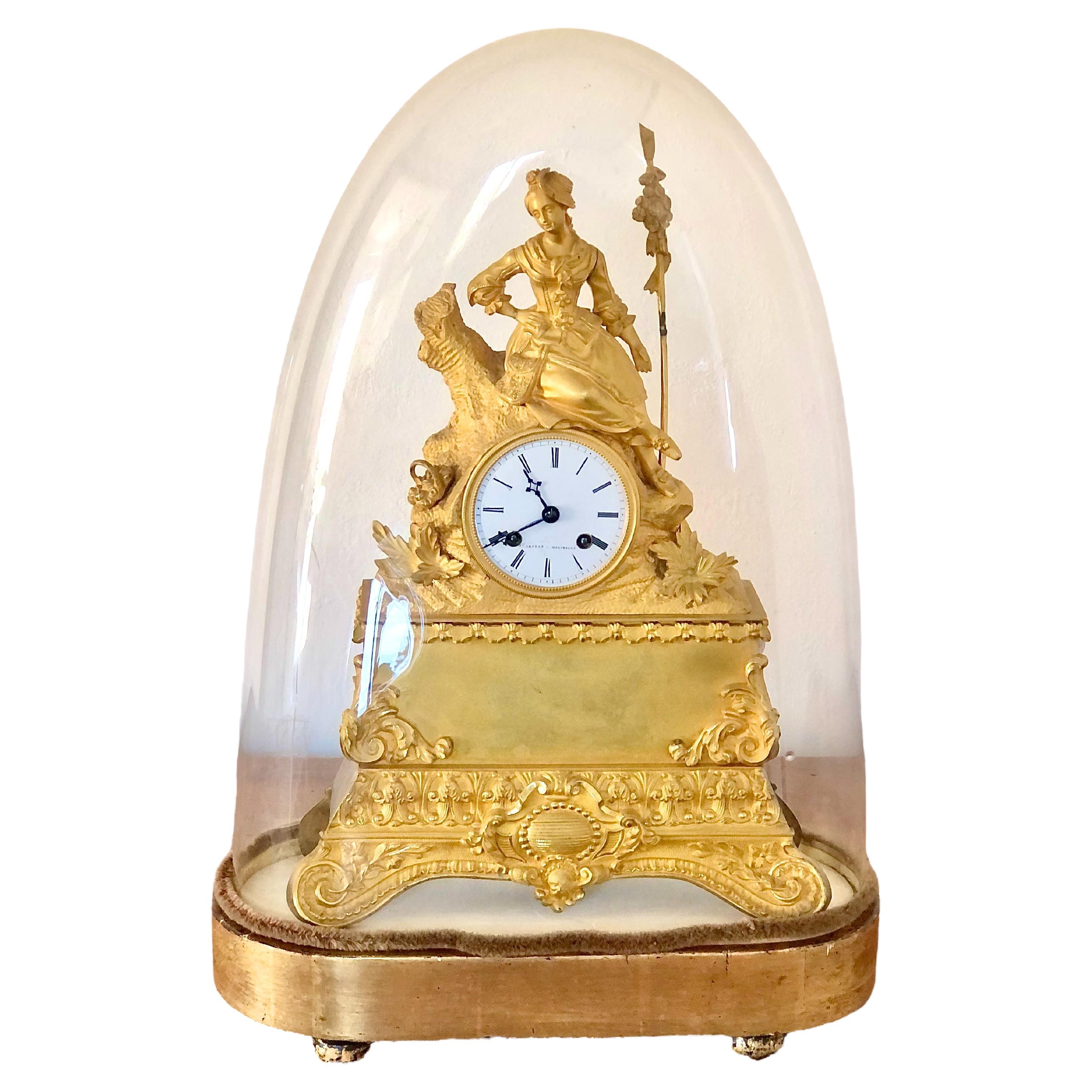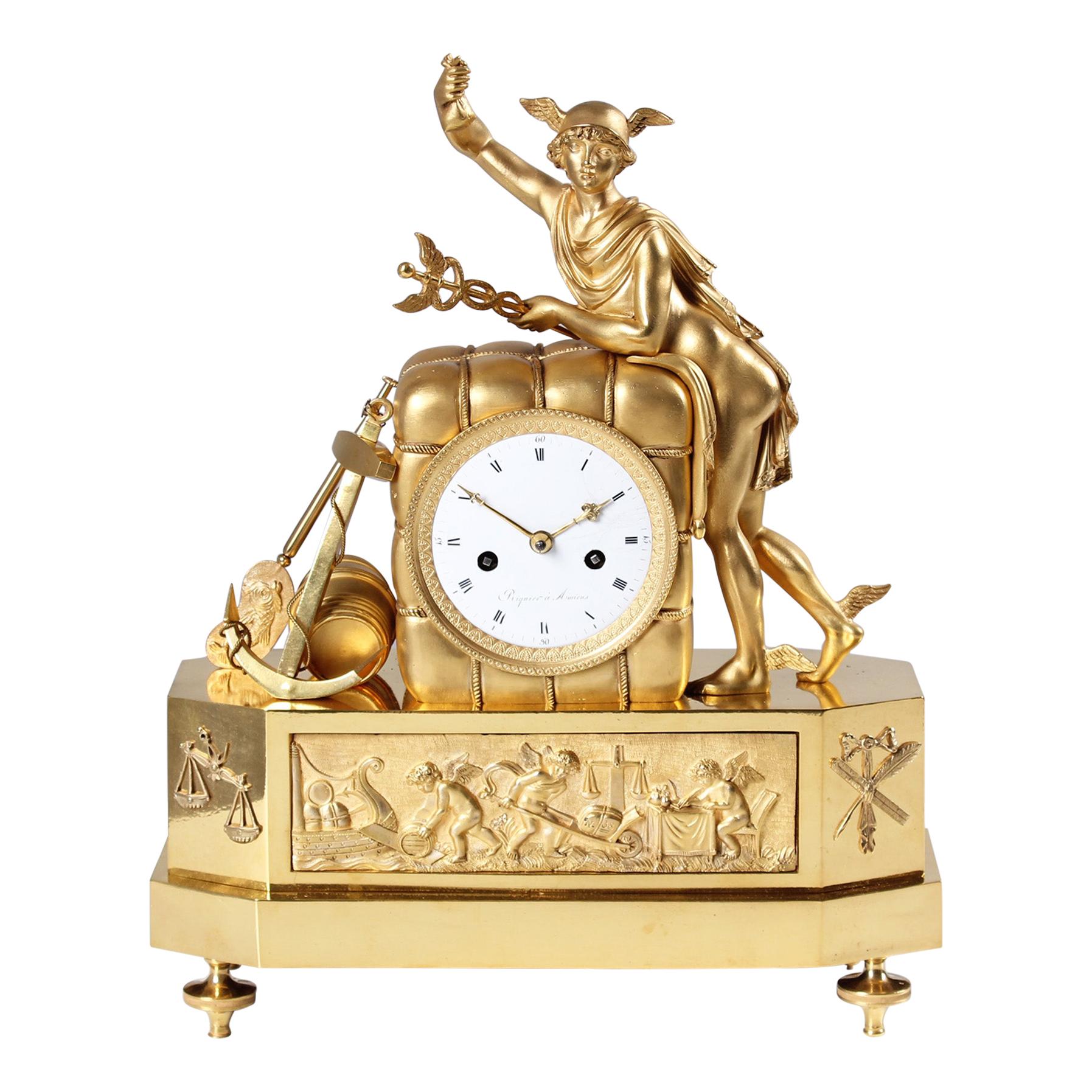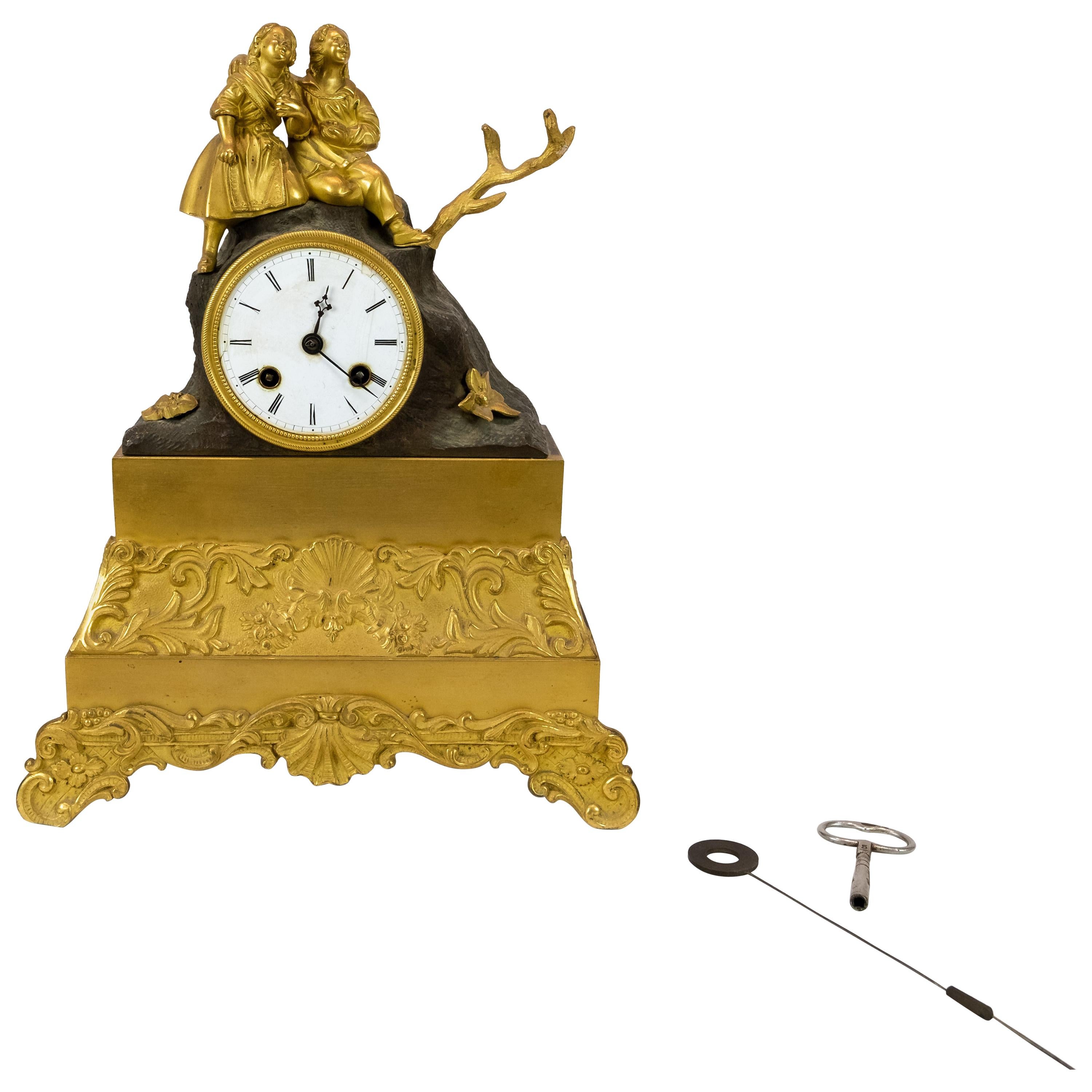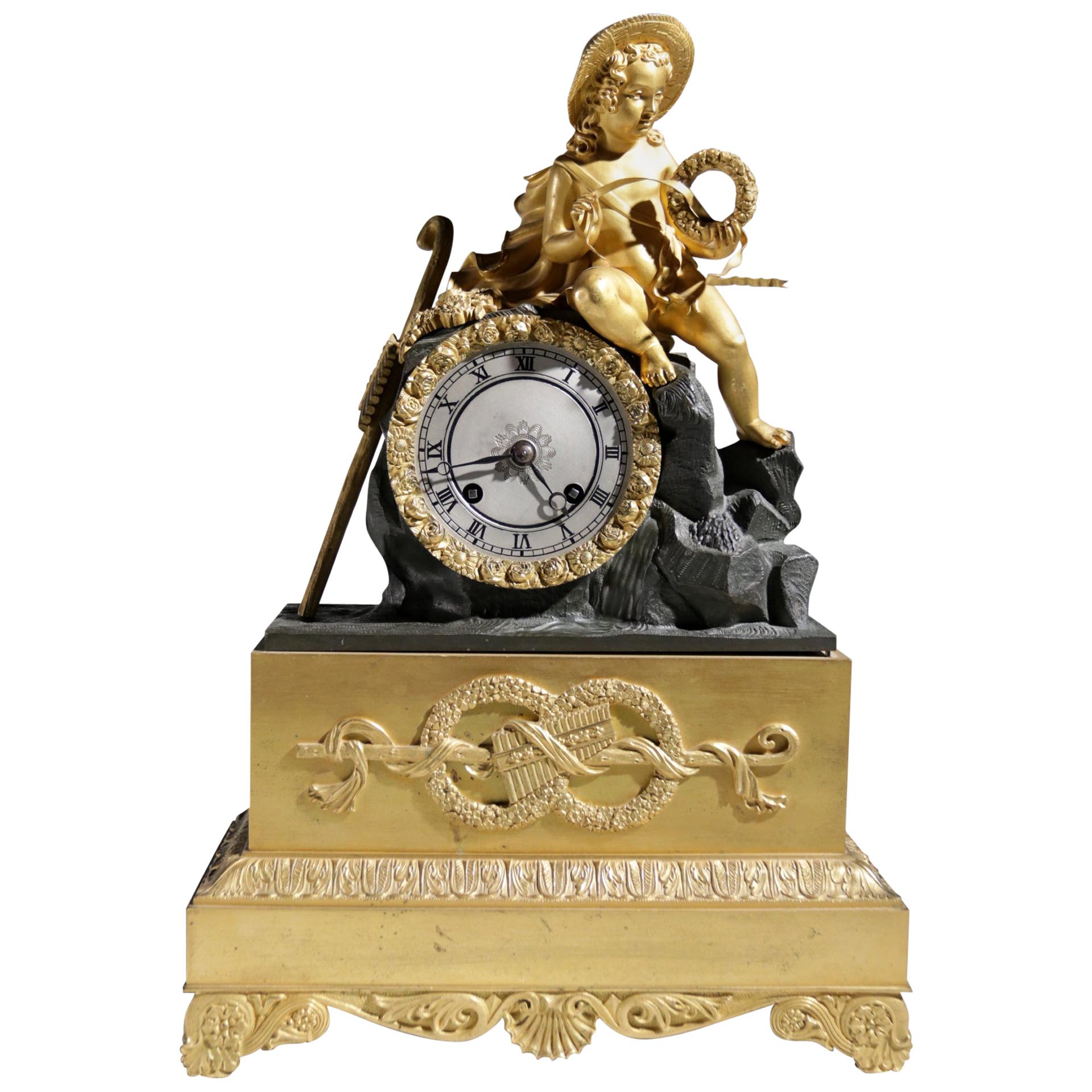Items Similar to France, circa 1810 -1820 Table Clock with a Handmaid Mercury Gilded Bronze
Want more images or videos?
Request additional images or videos from the seller
1 of 16
France, circa 1810 -1820 Table Clock with a Handmaid Mercury Gilded Bronze
About the Item
France, circa 1810 -1820
Table clock with a handmaid
Mercury gilded bronze, alt. cm 59.5 x 40.5 x 13
Signed in the quadrant "Sezille Palais Royal Nº 133 à Paris"
Akin to the prevailing taste of the Napoleonic era that envisaged a return to antiquity, the Empire Style was used for the decoration of furniture, architectural structures, furnishings, wall hangings and fabrics. The style envisaged a classical return to order, embellished by the antiquarian whimsy inspired by the recent archaeological discoveries at Herculaneum and Pompeii: the constant Roman and Hellenistic remembrance was celebrated through applications depicting laurel or oak garlands, imperial symbolism, mythological figures, sphinxes, muses, personifications and more.
This watch organises the mechanical case on a parallelepiped supporting structure, subdivided into two parts connected by a sinuous greek decoration with flowers; the whole structure rests on the plane by means of convex feet decorated with a dense network of small flowers inscribed within a modular rhombus, culminating, in the attachment to the central body of the watch, with a theory of palmettes. The upper part of the parallelepiped body, inscribed with mythological figuration like the ancient stelae, encloses the latter with a frame of stylised palm leaves interspersed with discs of flowers, in turn accompanied, on the two vertical sides, by a lively vegetal triumph. Considering the iconographic range used by the bronzeworkers for the decoration of the clocks, it is possible to recognise in the mythological scene depicted the muse of poetry and music, Calliope, accompanied by the attributes of the lyre and the laurel branch, used to pay homage to poets. The two winged geniuses in front of her carry scrolls and plates on which to engrave the verses the muse dictates daily to men; the reward for human intellect is emphasised by the two similar crowns the muse holds in her hands, depicting a serpent biting its tail. This symbol, which the mediaeval era would borrow from the Hellenistic-Roman environment of Gnosticism by creating the figure of the uroboros, metaphorically manifests the purpose of the clock, being used to personify the eternal return of time and the cyclical nature of the material life of men.
The case of the watch is enclosed in a zither, which is flanked by a woman crowned with laurel; the upper part has two griffin heads in correspondence with the arms of the zither, and a second female face crowned with a ring of petals/rays, again alluding to the sublime elevation of poetry. On the right side of the instrument rests a lighted torch accompanied by an extinguished upside-down torch, an allusion to present well-being, victorious over the failings of life, to which the bust of a philosopher in a disc also alludes. The dial has a porcelain ring while the hands are Breuguet. Mechanism with "anchor" escapement with silk-wire pendulum and chime with "partiora" system, sounding at the passage of the hours and half-hours.
The signature on the watch, “Sezille Palais Royal n°133 à Paris”, indicating the manufacture, allows the work to be dated between 1820 and 1841, the years in which Louis Sézille, a watchmaker, worked in the 'Palais Royal' in Rue du Marché Neuf, Galerie de Pierre 133.
- Dimensions:Height: 23.63 in (60 cm)Width: 16.15 in (41 cm)Depth: 5.12 in (13 cm)
- Materials and Techniques:
- Place of Origin:
- Period:
- Date of Manufacture:circa 1810-1820
- Condition:Wear consistent with age and use.
- Seller Location:Milan, IT
- Reference Number:1stDibs: LU5918233214572

About the Seller
5.0
Vetted Seller
These experienced sellers undergo a comprehensive evaluation by our team of in-house experts.
Established in 2000
1stDibs seller since 2021
26 sales on 1stDibs
Typical response time: 13 hours
- ShippingRetrieving quote...Ships From: Milan, Italy
- Return PolicyA return for this item may be initiated within 14 days of delivery.
More From This SellerView All
- piemontese mirror, Louis XVI, Gilded woodLocated in Milan, ITPiedmont, Louis XVI Mirror with selvage Carved and gilded wood, 164 x 104 cm Light, 90 x 70 cm The Louis XVI mirror under consideration, clearly manufactured in Piedmont, was mad...Category
Antique 18th Century Wall Mirrors
MaterialsGiltwood
- 20th Century Child with Hat Sculpture Bronze by Tommaso CampajolaBy Thomas CampajolaLocated in Milan, ITTommaso Campajola (Active in Naples between the 19th and 20th centuries) Child with hat Bronze, height 23 cm Signed and dated 1932 on the back.Category
20th Century Figurative Sculptures
MaterialsBronze
- 17th Century Frame Carved and Gilded Mecca WoodLocated in Milan, IT17th century, central Italy Frame Carved and gilded mecca wood, 67 x 92 cm Light 45 x 71 The frame in question is gilded mecca wood, carved with leaf decorations on two o...Category
Antique 17th Century Italian Picture Frames
MaterialsWood
- 17th Century Casket Venetian School Laquered and Gilded WoodLocated in Milan, IT17th century, Venetian School Stipo - Casket Lacquered and gilded wood, Measures: H. 46 cm; 50 x 31 cm Elegant cabinet of imperious and noble presence. The leonine corbels highl...Category
Antique 17th Century Italian Decorative Baskets
MaterialsWood
- Pair of angels in gilded wood Rome 17th centuryLocated in Milan, ITRome, 17th century Pair of angels Gilded wood, cm h 92 - Base, cm 25 x 40 The pair of putti examined is a masterpiece of the Roman Baroque period, a period of pomp and opulence w...Category
Antique 17th Century Italian Figurative Sculptures
MaterialsWood
- Three Louis XVI 18th Century gilded wood wall mirrorsLocated in Milan, IT18th century, Louis XVI Wall cartoons (3) Carved and gilded wood, 60 x 40 cm - 35 x 36 cm Light, 30 x 26 cm - 14 x 13 cm The three pieces of furniture in question represent splen...Category
Antique 18th Century Louis XVI Pier Mirrors and Console Mirrors
MaterialsMirror, Wood
You May Also Like
- Ormolu Mantel Clock, Belgium, circa 1810-1820Located in Belmont, MAEmpire ormolu mantel clock, Belgium, circa 1810, Signed "J.B. Romaet a Gand". Decorated with a shepherd scene. Strikes the hour and half hour on a bell. With enamel clock face and si...Category
Antique 1810s Belgian Empire Mantel Clocks
MaterialsOrmolu
- 19th French Empire Mantel Clock, Pendule, Mercury, Gilded Bronze, circa 1815Located in Greven, DE19th century French pendule, mantel clock - Mercury the messenger of the gods France Bronze gilded Empire around 1815 Dimensions: H x W x D: 37 x 30 x 10 cm Description: French Empire...Category
Antique Early 19th Century French Empire Mantel Clocks
MaterialsBronze
- French Fireplace Clock Made In Gilded Bronze From 1820sLocated in Lejre, DKThe French fireplace clock from the 1820s exudes timeless elegance and sophistication. Crafted from luxurious gilded bronze, this exquisite timepiece showcases the opulence and refin...Category
Antique 1820s French Art Deco Mantel Clocks
MaterialsBronze
- Empire Fire Gilded Mantel Clock, circa 1820Located in Boven Leeuwen, NLBeautiful fire gilded Empire mantel clock with a shepherdess on top with a wreath and ribbon. On the left a staff with pan flute. At the bottom of the clo...Category
Antique Early 19th Century French Empire Mantel Clocks
MaterialsBronze
- French Empire Guilt Bronze Mounted Table Clock on Marble Circa 1820Located in Lincoln, GBThis is an exceptional quality French Empire Guilt Bronze mounted clock circa 1820.Category
Antique 19th Century Table Clocks and Desk Clocks
MaterialsMarble, Bronze
- French Antique Gilded Chiseled Bronze ClockLocated in LA CIOTAT, FRA superb quality 19th century French bronze gilt mantel clock, retaining its original glass dome, and adorned with a finely detailed rustic female figure in period dress, reclining o...Category
Antique 19th Century French Mantel Clocks
MaterialsBronze
Recently Viewed
View AllMore Ways To Browse
French 1810
1810 France
French Gilded Table
Gilded Bronze Tables
Small Gilded Frame
French Antique Gilded Table
Gilded Clock
Gilded Bronze Signed
Gilded French Clock
Tables From 1820
French Gilded Antique Clocks
Bronze Gilded Frame
Mercury Bronze
Gilded Bronze Clocks
Royal Palais
Bronze Figures Table
Bronze Of Mercury
Bronze French Table Clock





